Here’s to Beer Flavor
INGREDIENTS
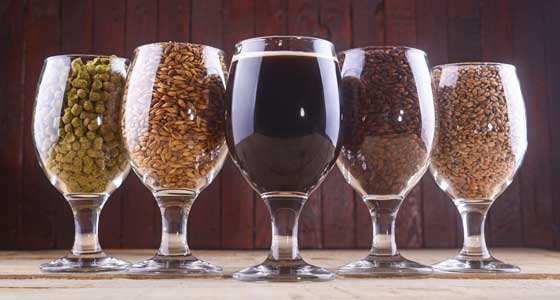
Changing consumer tastes and competition are challenging the beer and craft beer industry. A quarter of beer drinkers reported that they drank less beer in 2017 than they did in the previous year (many are choosing other alcoholic beverages instead), and both dollar and volume sales of beer have slowed a bit, according to market research firm Mintel (2017). This can be overcome, though. Mintel predicts that the slumping sales of beer and craft beer will change course and see a slow and steady growth through 2022 due to widespread adoption, affordability, and accessibility of beer and craft beer. Something else that will spur the turnaround is a wide and varied range of beer and craft beer products to excite and engage consumers, reports Mintel. One quality of food and beverages that surely appeals to consumers and captures their attention is flavor.
Flavored beers offer brewers an opportunity for growth, and improving taste offerings will keep the competition from other alcoholic beverages at bay, reports Mintel. In fact, Mintel notes that there is already an increasing range of flavored beer launches. Something else happening on the flavor front is research into understanding more about how hops, malted barley, and yeast contribute to beer’s flavor and the development of hop-derived ingredients, new barley varieties, and enhanced yeast strains.
Formulating a Tasty Bottle of Beer
Brewing beer takes nothing more than malt, yeast, hops, and water. It’s a simple ingredient list, but each ingredient plays a specific role in the brewing journey through a complex and interesting biochemical process.
When you admire the range of colors from golden yellow to amber to inky black and indulge in the nutty, sweet, caramel, or burnt aroma and flavor notes of beer, you have malt to thank. It is a major player in the development of aroma, flavor, color, and body of beer. Barley is most commonly used to produce malt, but other grains like wheat, rye, corn, rice, and oats can be used as well. Barley is typically the grain of choice because it contains large amounts of starch that can be converted into sugar, is neutral in flavor, is light in color, and contains plenty of enzymes that break down starches and proteins.
Malting involves steeping, sprouting, and then kiln drying barley. The process releases enzymes that convert some of the starches into sugars that the yeast will later use to ferment the beer. Color develops during the drying portion. The malt can also be roasted or smoked to develop unique layers of flavor and to darken the color.
Brewers can choose from many different malt-based ingredients to suit specific beer formulations. Briess Malt & Ingredients Co. produces an extensive line of standard and specialty malts, malt extracts, brewer’s flakes, and filtering aids for both large and small brewers, controlling its supply chain from seed to finished ingredient. Muntons is another player in the malt industry, offering grain malts, liquid malt extracts (produced by the aqueous extraction of sugars from malted barley and then concentrated into a viscous syrup to be used as a partial grain malt replacement or a brew extender), and spray-dried malt extracts (for use as an alternative base material or an extender).
Standard, or base, malts contain high amounts of enzymes, sugars, and complex carbohydrates that are important in the fermentation portion of the brewing process, while specialty malts are produced when the length of time, temperature, or humidity of steeping, germination, and drying are adjusted to develop specific flavors and colors, or distinctive functionality, according to Briess. From this, Briess produces specialty malts such as kilned base malts that produce pale yellow-colored beers with sweet and mild malty flavors, and high temperature kilned malts that give beer a golden color and light malty to intensely malty and biscuity flavors. Next up are roasted caramel malts that, as the name suggests, produce beer with a caramel color and sweet, mild to intense caramel, toffee, or burnt sugar flavors, and specialty processed malts that create beers in rich amber hues with biscuity, toasty, nutty, woody, and raisin flavors. Finally, we turn to the dark side with dark roasted malts that produce rich roasted coffee or cocoa flavors and roasted barley for coffee flavors that are quite bitter and dry. The malts in both categories give beer opaque, very dark brown/black color.
Earlier this year, Briess added Dark Munich Malt 30L to its collection of specialty malts. It’s a European-style Munich malt hybrid typically used to brew brown ale, bock, Oktoberfest/Märzen, Scotch ale, or any beer that benefits from enhanced malty flavor, according to the company. The overall flavors it gives beer are sweet, big malty flavors with slight toasty notes, but depending on the usage levels, flavors and aromas of caramel, honey, molasses, brown sugar, dried fruit, bread crust, biscuits, toast, prunes, vanilla, and/or nuts can develop. The same goes for color development; a 15% usage level produces beer with a light brown hue while a 50% usage level gives beer a ruby brown hue.
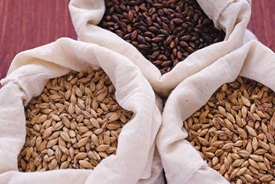 The contributions of the malting process and malted barley to the flavor of beer is documented. But what about the contributions of the actual barley grain beyond the malting process? That’s what a group of U.S.- and UK-based researchers wanted to determine when they set up a research study to see if certain barley varieties and the environment and location in which the barley was grown affect the flavor of beer (Herb et al. 2017). They demonstrated that barley genotype and the growing environment can contribute to the flavor of beer, says Patrick Hayes, professor of barley breeding and genetics at Oregon State University and one of the study’s authors. Insights like these may help to create “a heightened awareness in the beer brewing industry of the potential for barley to make unique flavor contributions to beer, and a protocol for assessing those contributions,” says Hayes.
The contributions of the malting process and malted barley to the flavor of beer is documented. But what about the contributions of the actual barley grain beyond the malting process? That’s what a group of U.S.- and UK-based researchers wanted to determine when they set up a research study to see if certain barley varieties and the environment and location in which the barley was grown affect the flavor of beer (Herb et al. 2017). They demonstrated that barley genotype and the growing environment can contribute to the flavor of beer, says Patrick Hayes, professor of barley breeding and genetics at Oregon State University and one of the study’s authors. Insights like these may help to create “a heightened awareness in the beer brewing industry of the potential for barley to make unique flavor contributions to beer, and a protocol for assessing those contributions,” says Hayes.
The results also generated insights into the barley plant itself. “This research opened a completely new way of looking at barley breeding—what is barley terroir?” says Dustin Herb, department of crop and soil science courtesy faculty at Oregon State University and one of the study’s authors.
The study examined a limited number of barley varieties and used micromalting and nanobrewing methods, so both Hayes and Herb would like to see future experiments on this topic scaled up to include larger sample sizes. Since the goal of the researchers is to release a variety for commercial production, it is important that the protocol for assessing these contributions are representative of full-scale production, says Herb. “Therefore, validation of results in scaled-up experiments is key.”
Hops contain resins and essential oils that contribute to the flavor and aroma of beer. These small green cones covered in a papery coating add bitterness to beer and, depending on the variety of hop, can provide aromas of fruit, citrus, pine, herb, floral, spice, and grass. Just as brewers choose from one of the many different malting barley varieties to achieve desired flavors, aromas, and colors, so too do they choose hops.
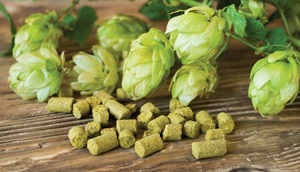 While some breweries follow the traditional method of adding whole hops to the wort (a starchy-sugary liquid resulting from heating malt and water), many others use hop pellets (produced from hops that have been milled and pelletized) or liquid extracts of hops. “Fifty percent of the worldwide distribution of hop products can be assigned to hop extracts, including CO2 extract and advanced hop extracts,” says Tatiana Praet, hops lead scientist at Kalsec. “Brewers have been using advanced hop extracts for over 40 years because these ingredients provide many advantages such as bitterness addition, light stable bitterness, foam stability, unique hop aroma profiles, higher utilization of high-value hop components, and economic advantages.” Large brewers rely on these types of ingredients to help them ensure flavor consistency, one of the most important quality factors, says Praet. “In addition, we have observed a trend towards increasing usage of advanced hop aroma extracts by the craft brew industry. As the craft brew industry grows larger and competition increases, craft brewers need to be able to differentiate their beers by creating distinct flavor profiles and deliver consistency.”
While some breweries follow the traditional method of adding whole hops to the wort (a starchy-sugary liquid resulting from heating malt and water), many others use hop pellets (produced from hops that have been milled and pelletized) or liquid extracts of hops. “Fifty percent of the worldwide distribution of hop products can be assigned to hop extracts, including CO2 extract and advanced hop extracts,” says Tatiana Praet, hops lead scientist at Kalsec. “Brewers have been using advanced hop extracts for over 40 years because these ingredients provide many advantages such as bitterness addition, light stable bitterness, foam stability, unique hop aroma profiles, higher utilization of high-value hop components, and economic advantages.” Large brewers rely on these types of ingredients to help them ensure flavor consistency, one of the most important quality factors, says Praet. “In addition, we have observed a trend towards increasing usage of advanced hop aroma extracts by the craft brew industry. As the craft brew industry grows larger and competition increases, craft brewers need to be able to differentiate their beers by creating distinct flavor profiles and deliver consistency.”
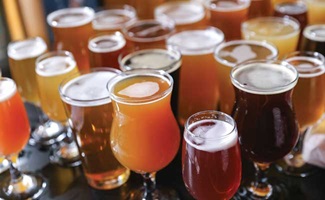 The hops scientists at Kalsec developed a line of hop extracts to enhance the craft brewing process by supplementing traditional hopping and allowing craft brewers to easily adjust beer flavor characteristics to achieve their desired profile. Each liquid hops extract ingredient in the Craft Brew Solutions line is specifically formulated to contribute distinct flavor and aroma. Bitter Blaster, for instance, is hop-isomerized alpha acids that heighten the bitterness of beer in an easy-to-use and consistent format, while Hopfenatic is a blend of hop oil fractions (sesquiterpenoids, terpene alcohols, and hop esters) that provide hop aroma and hop flavor without bitterness. There’s also a blend of tropical flavors and hop oils to give beers a fruit flavor and aroma similar to the Citra hop variety (HopCitrAles) and a blend of natural grapefruit flavor and hop oils to provide beer with the trendy grapefruit background flavor similar to the Cascade and Centennial hop varieties (Trop Hopical). Hop HySterian is a blend of hop-derived terpenes, esters, sesquiterpenes, and terpene alcohols that have floral, fruity, and spicy characteristics.
The hops scientists at Kalsec developed a line of hop extracts to enhance the craft brewing process by supplementing traditional hopping and allowing craft brewers to easily adjust beer flavor characteristics to achieve their desired profile. Each liquid hops extract ingredient in the Craft Brew Solutions line is specifically formulated to contribute distinct flavor and aroma. Bitter Blaster, for instance, is hop-isomerized alpha acids that heighten the bitterness of beer in an easy-to-use and consistent format, while Hopfenatic is a blend of hop oil fractions (sesquiterpenoids, terpene alcohols, and hop esters) that provide hop aroma and hop flavor without bitterness. There’s also a blend of tropical flavors and hop oils to give beers a fruit flavor and aroma similar to the Citra hop variety (HopCitrAles) and a blend of natural grapefruit flavor and hop oils to provide beer with the trendy grapefruit background flavor similar to the Cascade and Centennial hop varieties (Trop Hopical). Hop HySterian is a blend of hop-derived terpenes, esters, sesquiterpenes, and terpene alcohols that have floral, fruity, and spicy characteristics.
In addition to the Craft Brew Solutions hop extracts, Kalsec produces advanced hop extracts that provide various functions to the brewing industry. There are a couple of ways to use the company’s advanced hop extracts. “A lot of brewers use some form of more conventional hop product in the kettle and then add advanced hop extracts at a later stage to adjust bitterness and impart appealing hop aromas,” says Praet. “Other brewers use solely advanced hop extracts and add hop oil extracts in conjunction with hop acid extracts. Avoiding the usage of conventional hop products is crucial for brewing light-stable beers. By cutting down on the quantity of hops and replacing this portion by hop extracts, brewers can significantly increase their hop utilization and reduce their beer loss.”
Kalsec’s neat hop oils are high-purity fractions of hops that provide hop flavors and aromas like those produced during the stages of the brewing process. To produce its hop acid ingredients, the company uses extraction technology to separate and purify hop acid fractions, the compounds in hops that provide various bitter flavor precursors. Each hop acid ingredient in the line offers a different bitterness impact that can range from producing a smooth bitterness to a sharper bitterness at the back of the tongue. Brewers looking to streamline production and reduce waste might find kettle aroma extracts useful. These aroma extracts are derived from hops and formulated to supplement or replace brew kettle flavor and aroma hopping. All aroma extracts provide flavor, with some formulated to impart hop bitterness and others to give hop character without bitterness.
Yeast are tiny organisms with a big responsibility in making beer: converting sugar into alcohol. Specifically, yeast consume sugar and produce ethyl alcohol, or ethanol, carbon dioxide, and small amounts of other compounds such as flavor and aroma compounds like esters, sulfur-containing compounds, diacetyl, and more. There are two main species of yeast used in beer brewing, ale yeast called Saccharomyces cerevisiae and lager yeast called S. pastorianus. Companies such as White Labs, which specialize in yeast, develop different strains of yeast from these species and others for use in beer brewing. Each strain produced is perfectly suited for brewing a certain style or styles of beer and can contribute different flavors and aromas. They also vary across a range of other characteristics such as alcohol tolerance, the temperature ranges at which they ferment, how well they convert sugar into alcohol, how well they grow and multiply, and whether they sink or float in the fermentation tank. Some craft brewers use completely different yeast species that go beyond cultured yeast, and even bacteria (Lactobacillus and Pediococcus) to brew wild fermented beers and sour beers. Various strains of the wild yeast Brettanomyces produce complex earthy flavors with aromas described as hay-like, barnyard, horsey, smoky, or pineapple-like. The bacteria strains are used help punch up acidic tastes and sour notes in sour beer styles like lambics, sour ales, and gueuze.
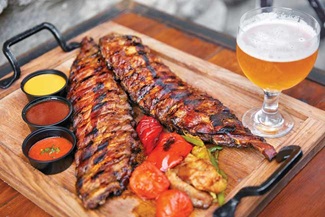 Beer Flavors Cross Over Into Food
Beer Flavors Cross Over Into Food
Beer flavors in finished food products are trending, according to Kalsec. Citing research from Innova Market Insights, which found that there was an 8% increase in new product introductions for foods with beer-style flavors from 2016 to 2017, Kalsec reports that there is room for more growth in the use of these flavors across many food categories (Kalsec 2018a). The top categories of these product introductions are sauces, seasonings, meats, and snacks. Kalsec combined its hop product development knowledge with culinary expertise to develop a line of beer-style flavor profiles—five in all—to give food products authentic beer flavors. They are made from a combination of spice and herb flavor extracts, natural flavors, and hop extracts, are not made with genetically modified ingredients, and are nonalcoholic. The beer styles represented in the collection were chosen to provide a range of popular styles of craft beers, says Lindsay Bond, culinary scientist at Kalsec. Lemon Shandy has sweet lemon and beer-type aromas while Porter features rich chocolate notes with coffee and beer-type aromas. Pumpkin Spice is a blend of warm spices of cinnamon, clove, and nutmeg with beer-type aromas, and Wheat has orange, clove, and beer-type aromas. Finally, there is IPA, which captures the intense hop and grapefruit characteristics of an IPA beer along with beer-type aromas. Having a choice of beer-style flavors gives product developers the opportunity to add more specificity to their products, such as formulating a porter barbecue sauce, IPA sandwich spread, or lemon shandy hard candy, rather than using the generic term “beer flavor” in the product name.
Beer itself does not function well in many processing techniques, making formulating with it tricky. That’s why product developers turn to beer-style flavors, which offer stability and consistency. What’s more, the beer-style flavors are easy to use and give food formulators the ability to get the aroma and flavor of each beer style in a finished food product, says Bond. They are also heat stable, she adds, and can withstand the rigors of baking, frying, and retorting.
Kalsec recently conducted an online survey into craft beer preferences, which generated insights into flavors that craft beer brewers value most and which ones they would like to be available to them to use in their beer (Kalsec 2018b). The top three flavors that the brewers said they are interested in for beer are fruit flavors: blood orange, passion fruit, and raspberry. The other preferred flavor recommendations are chocolate, pumpkin spice, cherry, barrel aged, maple, and heat and spice from hot peppers. Kalsec also notes the increasing use of botanicals such as spices, herbs, tree sap, spruce tips, and pine needles in craft beer (Kalsec 2018c). Examples of beers that can incorporate such flavors and ingredients include habanero ales, sweet heat wheat ales, and ancho stouts.
Spiking Food Products
Earlier this year, Givaudan introduced its Givaudan Brewer’s Collection. This line includes natural beer WONFs that represent some of the most popular styles with consumers today, including IPA, hefeweizen, and saison, says Tess Sansbury, a beverage senior category manager at Givaudan. There’s also a selection of natural hop flavors representing the variety that can be found within this single ingredient and a selection of natural flavor extractives like malt, rye, grain, and oak that can be used to create complex and unique beer profiles that can be used in food and beverage products, both in and outside of the beverage alcohol segment, she adds.
To dig a little deeper into how beer and beer flavors resonate with consumers, Givaudan prepared some consumer insights and discovered some key takeaways that can help product developers elevate their products with beer flavors. “Beer is incredibly personal, and our consumer research certainly validated this,” says Sansbury. “Most people like beer. But what exactly is beer to them? A craft IPA? A seasonal brew with interesting notes? Or, a ‘cold one’ from the camp cooler? The answer? ‘Yes,’ to each of them, because beer is personal and a holistic experience.”
One of the findings pointed out that consumers are interested in craft beer, but not exclusively, with 46% of consumers indicating that they consume both craft and mainstream beer. In addition to enjoying craft beer and mainstream beer, they are also imbibing in shandies, beer cocktails, flavored beer, and cider. “In fact, only 4% were strictly loyal to the mainstream brands and only 8% drink craft exclusively,” says Sansbury. “This is a consumer group that desires experimentation through new flavors, new brands, new products, and, of course, seasonal LTO (limited-time only) offerings.”
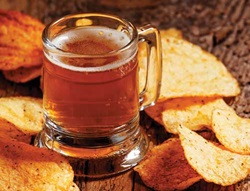 A couple of other findings from Givaudan’s consumer insights research about beer are of interest to product developers who are considering formulating with beer flavors. The first is that two out of three consumers are interested in beer flavors for potato chips, pretzels, cheese sauces and dips, sandwich spreads, condiments, dipping sauces, chocolate sauce, and caramel sauce. The second is that three out of four consumers are interested in beer flavors for chocolate candy, barbecue sauces, and meat marinades. The findings show strong opportunities for launching beer-flavored products, particularly in the snack foods and sauces categories. Other products to consider spiking with beer and hop flavors are bread, cakes, hard candy, meat products such as jerky, and both alcoholic and nonalcoholic beverages.
A couple of other findings from Givaudan’s consumer insights research about beer are of interest to product developers who are considering formulating with beer flavors. The first is that two out of three consumers are interested in beer flavors for potato chips, pretzels, cheese sauces and dips, sandwich spreads, condiments, dipping sauces, chocolate sauce, and caramel sauce. The second is that three out of four consumers are interested in beer flavors for chocolate candy, barbecue sauces, and meat marinades. The findings show strong opportunities for launching beer-flavored products, particularly in the snack foods and sauces categories. Other products to consider spiking with beer and hop flavors are bread, cakes, hard candy, meat products such as jerky, and both alcoholic and nonalcoholic beverages.
“The Brewer’s Collection was an exciting experience to explore unique profiles, the impact on all food and beverage categories, and most importantly, taking a deep, confusing dive with consumers,” says Kasey Reed-Long, product manager on Brewer’s Collection. “There are a lot of misperceptions in this space, and I was a culprit of having some of these misperceptions, and the time we took to really understand how consumers identify themselves, what they enjoy about their brew, and what else they consume in this space really helped shape this collection and the direction we ended up going in for this launch.”
Next month’s Ingredients section will discuss plant-based protein ingredients.
 Karen Nachay,
Karen Nachay,Senior Associate Editor
[email protected]
References
Herb, D., T. Filichkin, S. Fisk, et al. 2017 “Effects of Barley (Hordeum vulgare L.) Variety and Growing Environment on Beer Flavor.” J. Am. Soc. Brew. Chem. 75(4): 345–353.
Kalsec. 2018a. “Beer Flavors in Food are Trending.” https://www.kalsec.com/beer-flavors-in-food-trending/.
Kalsec. 2018b. “Preferred Craft Brew Flavors.” https://kalsec.com/craft-brew-flavors/.
Kalsec. 2018c. “October Trend Brief: Craft Beer.” https://www.kalsec.com/october-trend-brief-craft-beer/.
Kirkpatrick, K. R., and T. H. Shellhammer. 2018. “Evidence of Dextrin Hydrolyzing Enzymes in Cascade Hops (Humulus lupulus). J. Agric. Food Chem. 66(34): 9121–9126.
Mintel. 2017. Beer and Craft Beer, U.S. October.Executive Summary. Mintel, Chicago. mintel.com.
Schulz, B. L., T. K. Phung, M. Bruschi, et al. 2018. “Process Proteomics of Beer Reveals a Dynamic Proteome with Extensive Modifications.” J. Proteome Res. 17(4): 1647–1653.